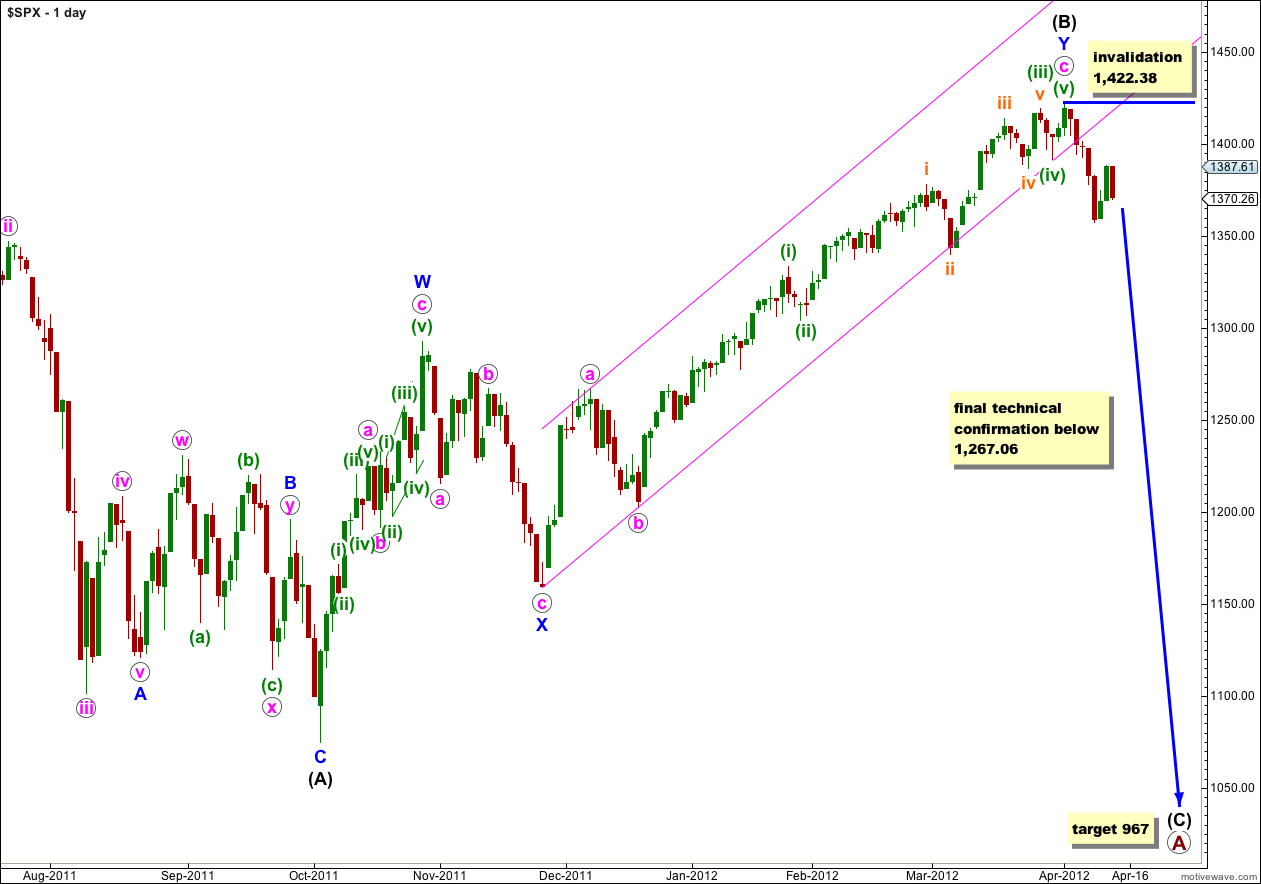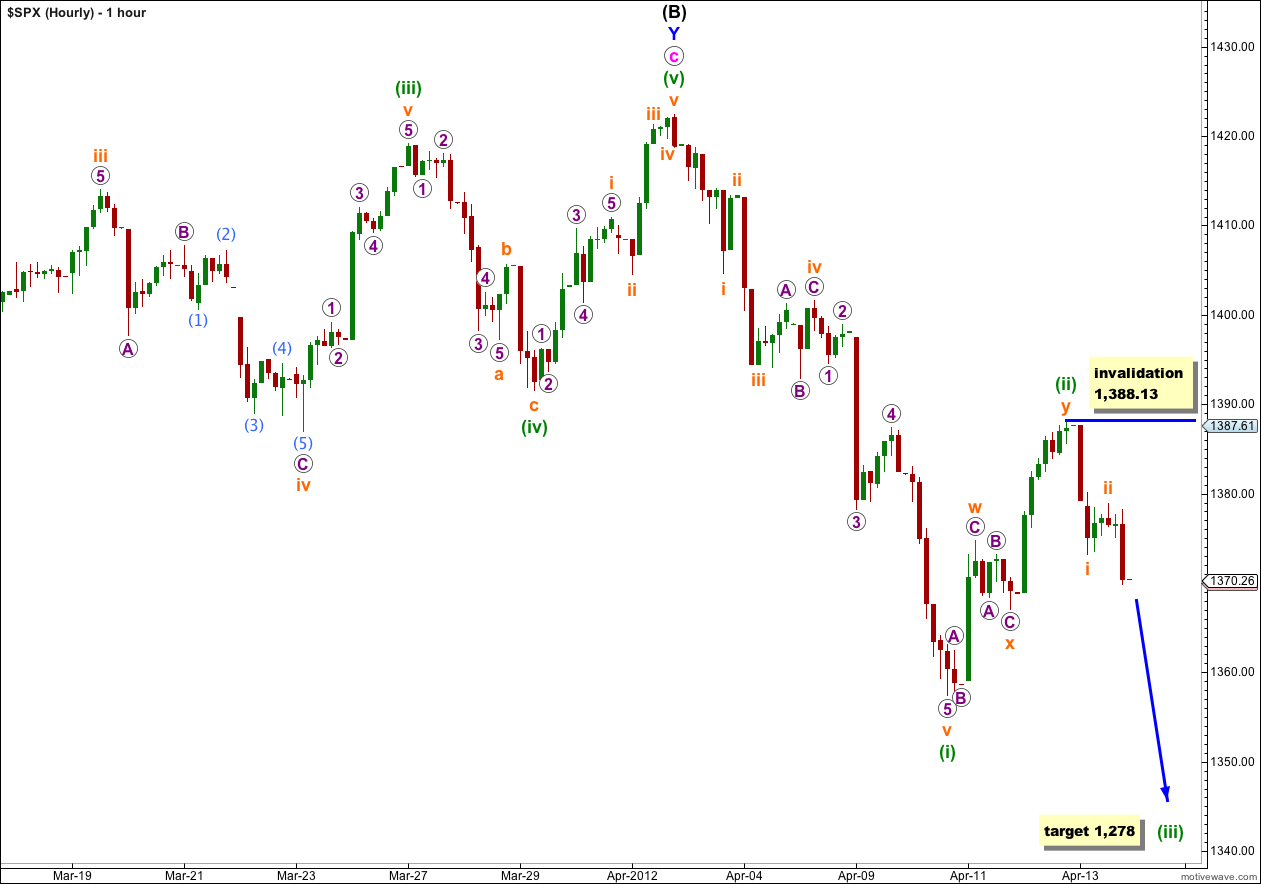As expected from our main wave count, after Thursday’s session the S&P 500 moved lower for Friday.
We may expect our short term target to be reached next week. Our long term target is months away.
Our alternate wave count is still valid. Only when the parallel channel on the daily chart of our alternate is breached may we have significant confidence in a trend change. Until then we must accept the risk that the alternate wave count could be correct.
Click on the charts below to enlarge.
At primary degree wave A would be an expanded flat correction because wave (B) black is a 123% correction of wave (A) black. We would expect wave (C) black to most likely reach 1.618 the length of wave (A) black a 967. If price moves through this first target then the next (less likely) target would be where wave (C) black reaches 2.618 the length of wave (A) black at 685.
Within wave (C) black no second wave correction may move beyond the start of its first wave. This wave count is clearly invalidated with any movement above 1,422.38.
This wave count has a typical look for wave c pink. The third wave is extended which is most common, and its subdivisions can be seen clearly on the daily chart which should be expected. It agrees with MACD in that within wave c pink the strongest reading is for the third wave.
Wave (B) black is a double zigzag structure which is a common structure. Within the first zigzag labeled W blue the subdivisions fit most neatly as a zigzag.
If the channel on the daily chart for the alternate wave count below is breached then we may have significantly increased confidence in this wave count. Movement below 1,267.06 would finally and technically confirm a large trend change.
With price moving below the high labeled w orange within (ii) green at 1,374.71, wave (ii) green may be finally confirmed as a complete structure. This structure subdivides most easily as a three. We have a five down, followed by a three up. We may now expect that we should see further downwards movement in a small degree third wave.
When wave (iii) green is complete we may draw a parallel channel about it. At green degree it is too early to draw a channel at this stage.
If my labeling of waves i and ii orange within (iii) green is correct then we may see an increase in downwards momentum during Monday’s session as the middle of a third wave unfolds. At 1,349 wave iii orange would reach 2.618 the length of wave i orange.
Wave i orange may not be over though. If we move the degree of labeling within (iii) green down one degree we may only have seen wave 1 purple within wave i orange complete.
Within wave (iii) green no second wave correction may move beyond the start of its first wave. This wave count is invalidated with movement above 1,388.13.
At 1,278 wave (iii) green would reach 1.618 the length of wave (i) green.
Alternate Daily Wave Count.
If the upwards wave labeled A blue here subdivides into a five then wave (B) black may be a single zigzag structure. This wave count has a fairly low probability because this wave subdivides most easily into a three, and it is difficult (but possible) to see it as a five. As a five it has a strange looking third wave which reduces the probability of this wave count.
However, we should consider the implications of the parallel channel about wave C blue. This channel has been nicely held to on the upper edge all along this long sustained rise, and until this channel is breached by downwards movement I want us to consider the possibility that we may yet see a final fifth wave up to new highs.
At 1,466 wave v pink would reach equality with wave i pink. Wave (B) black would be almost 138% the length of wave (A) black, the maximum common length for a B wave in relation to an A wave of a flat correction.
Wave iv pink may not move into wave i pink price territory. This wave count is invalidated with movement below 1,267.06. However, in practice I would discard this wave count before price gets that low, as a strong and significant breach of the parallel channel containing wave C blue would reduce the probability of this wave count.




Lara, thanks again for the counts and the targets. Your hard work is appreciated. The ebook is a neat little primer that should get your newer folks up to speed quickly. Best regards. mjo
You’re welcome Michael!